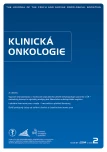Continuing Progress in Withdrawal of Axillary Dissection in Early Stage Breast Cancer
Authors:
D. Vrána 1,2; J. Gatěk 3,4
; K. Cwiertka 1; V. Šrámek 1
Authors place of work:
Onkologická klinika LF UP a FN Olomouc2 Oddělení toxikogenomiky, Centrum toxikologie a zdravotní bezpečnosti, Státní zdravotní ústav, Praha 3 Chirurgické oddělení, Nemocnice Atlas, Zlín4 Fakulta humanitních studií, Univerzita T. Bati ve Zlíně
1
Published in the journal:
Klin Onkol 2014; 27(2): 143-145
Category:
Sdělení
Summary
For a long period of time, axillary dissection represented a standard approach for axillary node management in the case of sentinel node biopsy positivity during early stage breast cancer treatment. In recent years, there has been a trend to highlight the morbidity of such an axillary procedure considering long‑term survival of early stage breast cancer patients. Two big trials, AMAROS and Z0011, were initiated to answer the question whether axillary dissection should be performed in the case of positivity of axillary sentinel node considering the fact that more than 70% of these patients will have no metastasis found during the axillary dissection and such a procedure only increases the morbidity of the surgery. Considering the results of the above mentioned trials, axillary dissection may be avoided in the case of fulfilling of inclusion criteria of these trials without any impact on the patient survival. IBCSG 23– 01 study brought similar conclusion in the case of micrometastasis in axillary sentinel node.
Key words:
axillary dissection – breast cancer – radiotherapy – breast-conserving surgery
Zdroje
1. Veronesi U, Paganelli G, Galimberti V et al. Sentinel‑ node biopsy to avoid axillary dissection in breast cancer with clinically negative lymph‑ nodes. Lancet 1997; 349(9069): 1864– 1867.
2. Giuliano AE, Hunt KK, Ballman KV et al. Axillary dissection vs. no axillary dissection in women with invasive breast cancer and sentinel node metastasis. JAMA 2011; 305(6): 569– 575. doi: 10.1001/ jama.2011.90.
3. Sabel SM. Re‑ evaluating the use of ALND in the context of Z0011. Breast Cancer Symposium 2013.
4. Harbeck N, Thomssen C, Gnant M. St. Gallen 2013: brief preliminary summary of the consensus discussion. Breast Care (Basel) 2013; 8(2): 102– 109. doi: 10.1159/ 000351193.
5. Eortc.org [homepage on the Internet]. EORTC – The future of cancer therapy. Available from: / / www.eortc.org/ news/ eortc‑ study‑ shows‑ radiotherapy‑ and‑ surgery‑ provide‑ excellent‑ regional‑ control‑ breast‑ cancer‑ pat.
6. Galimberti V, Cole BF, Zurrida S et al. Axillary dissection versus no axillary dissection in patients with sentinel‑ node micrometastases (IBCSG 23– 01): a phase 3 randomised controlled trial. Lancet Oncol 2013; 14(4): 297– 305. doi: 10.1016/ S1470- 2045(13)70035- 4.
Štítky
Dětská onkologie Chirurgie všeobecná OnkologieČlánek vyšel v časopise
Klinická onkologie

2014 Číslo 2
- Metamizol jako analgetikum první volby: kdy, pro koho, jak a proč?
- MUDr. Lenka Klimešová: Multioborová vizita může být klíčem k efektivnější perioperační léčbě chronické bolesti
- Realita léčby bolesti v paliativní péči v Německu
Nejčtenější v tomto čísle
- Aplikace poznatků psychoneuroimunologie v kontextu komplexní onkologické léčby karcinomu prsu
- Renálny onkocytóm s histologickými črtami invázie – kazuistika
- Další postupný ústup od axilární disekce u časného karcinomu prsu
- Lobulární karcinom prsu u muže – kazuistika a přehled literatury
